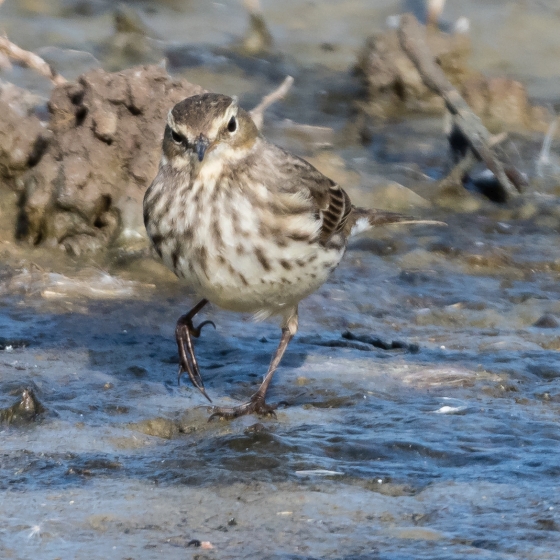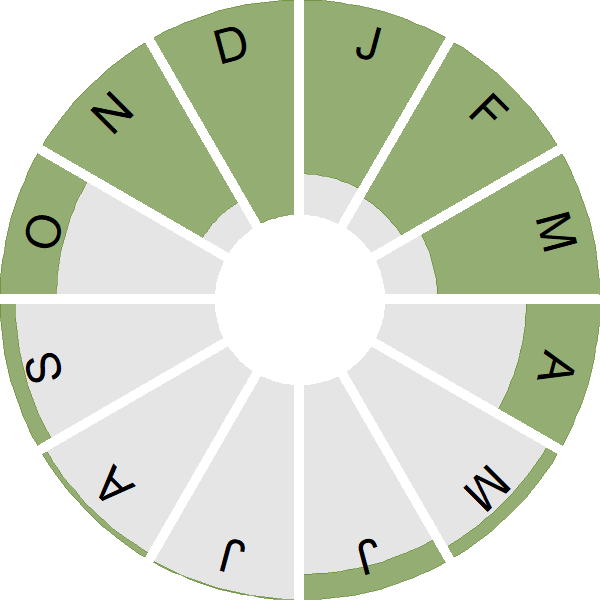Water Pipit

Introduction
The Alpine-breeding Water Pipit is a winter visitor to British and Irish wetlands, predominantly those found in the south. It arrives during September and October.
The Water Pipit has a curious behaviour in that part of the breeding population from the mountains of southern Europe move north for the winter. Its favoured habitat during the winter months is freshwater and coastal marshes in England – it is a scarce bird in Scotland and Wales and rare on the island of Ireland.
Water Pipits begin to head back to their breeding areas during April, by which time many are sporting their pink and grey breeding attire. It is estimated that around 300 individuals spend the winter months in Britain & Ireland, but there can be cold weather influxes.

Key Stats
Identification
ID Videos
This section features BTO training videos headlining this species, or featuring it as a potential confusion species.
Rock Pipit and Water Pipit
Songs and Calls
Song:
Flight call:
Status and Trends
Conservation Status
Population Size
Population Change
Water Pipit is a scarce winter visitor to the UK with approximately 200 individuals recorded each year [Woodward et al. 2020]. It has a southerly distribution and is associated with coastal areas as well as wetland and marshes in larger inland river valleys [Balmer 2013].
Distribution
Water Pipits are scarce winter visitors from alpine areas of southern Europe. They mostly winter in the south of Britain and Ireland with a bias towards the coast; inland records are associated with large wetlands and marshes in the larger river valleys. The highest counts were received from the English east coast between the Humber and Suffolk, and from the Fens.
Occupied 10-km squares in UK
or view it on Bird Atlas Mapstore.
or view it on Bird Atlas Mapstore.
European Distribution Map
Distribution Change
Change in occupied 10-km squares in the UK
or view it on Bird Atlas Mapstore.
Seasonality
Water Pipit is a winter visitor, arriving mostly from late October and remaining until April.
Weekly pattern of occurrence
The graph shows when the species is present in the UK, with taller bars indicating a higher likelihood of encountering the species in appropriate regions and habitats.

Movement
Britain & Ireland movement
Foreign locations of birds ringed or recovered in Britain & Ireland
Dots show the foreign destinations of birds ringed in Britain & Ireland, and the origins of birds ringed overseas that were subsequently recaptured, resighted or found dead in Britain & Ireland. Dot colours indicate the time of year that the species was present at the location.
- Winter (Nov-Feb)
- Spring (Mar-Apr)
- Summer (May-Jul)
- Autumn (Aug-Oct)

European movements
EuroBirdPortal uses birdwatcher's records, such as those logged in BirdTrack to map the flows of birds as they arrive and depart Europe. See maps for this species here.
The Eurasian-African Migration Atlas shows movements of individual birds ringed or recovered in Europe. See maps for this species here.
Biology
Productivity and Nesting
Nesting timing
Egg measurements
Clutch Size
Survival and Longevity
Survival is shown as the proportion of birds surviving from one year to the next and is derived from bird ringing data. It can also be used to estimate how long birds typically live.
View number ringed each year in the Online Ringing Report.
lifespan
Biometrics
Wing length and body weights are from live birds (source).
Ring Size
Classification, names and codes
Classification and Codes
- Order: Passeriformes
- Family: Motacillidae
- Scientific name: Anthus spinoletta
- Authority: Linnaeus, 1758
- BTO 2-letter code: WI
- BTO 5-letter code: WATPI
- Euring code number: 10141
Alternate species names
- Catalan: grasset de muntanya
- Czech: linduška horská
- Danish: Bjergpiber
- Dutch: Waterpieper
- Estonian: mägikiur
- Finnish: vuorikirvinen
- French: Pipit spioncelle
- German: Bergpieper
- Hungarian: havasi pityer
- Icelandic: Fjalltittlingur
- Irish: Riabhóg Uisce
- Italian: Spioncello
- Latvian: udenu cipste
- Lithuanian: vandeninis kalviukas
- Norwegian: Vannpiplerke
- Polish: siwerniak
- Portuguese: petinha-ribeirinha
- Slovak: labtuška vrchovská
- Slovenian: vriskarica
- Spanish: Bisbita alpino
- Swedish: vattenpiplärka
- Welsh: Corhedydd y Dwr

